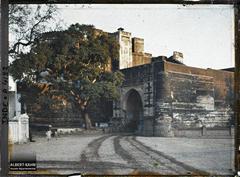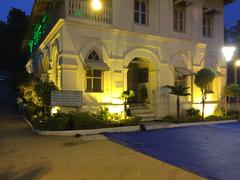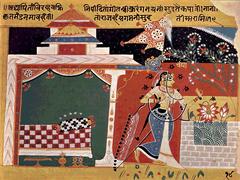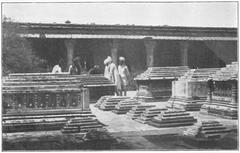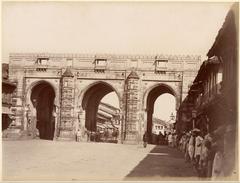Visiting Hours and Guide to Rani Sati Mandir in Ahmedabad
Date: 23/07/2024
Introduction
Table of Contents
- Introduction
- History of Rani Sati Mandir
- Architectural Significance
- Cultural and Religious Importance
- Modern Developments
- Community Involvement
- Visitor Information
- FAQ
- Conclusion
History of Rani Sati Mandir
Origins and Early History
The Rani Sati Mandir in Ahmedabad, India, is a significant religious site dedicated to Rani Sati, also known as Narayani Devi. According to legend, she was the wife of a merchant named Tandhan Das and committed sati, a historical practice where a widow self-immolates on her husband’s funeral pyre. Her act of devotion and bravery led to her deification, and she became a symbol of marital fidelity and strength.
Establishment of the Temple
The temple was constructed in the early 20th century by the Marwari community, who have a strong presence in Ahmedabad. The Marwaris, originally from the Marwar region of Rajasthan, are known for their entrepreneurial spirit and have significantly contributed to the economic development of Ahmedabad. The temple serves as a cultural and religious hub for the Marwari community in the city.
Architectural Significance
Design and Structure
The architecture of the Rani Sati Mandir is a blend of traditional Rajasthani and modern styles. The temple complex is adorned with intricate carvings, marble work, and vibrant frescoes depicting scenes from Rani Sati’s life and various Hindu deities. The main sanctum houses the idol of Rani Sati, beautifully decorated with traditional attire and jewelry. The temple’s architecture reflects the artistic heritage of Rajasthan and the devotion and craftsmanship of the Marwari community.
Cultural and Religious Importance
Rani Sati Mandir holds immense cultural and religious significance for the Marwari community and other devotees. The temple is a center for various religious activities, including daily prayers, bhajans (devotional songs), and special ceremonies during festivals. One of the most important events celebrated at the temple is the Rani Sati Fair, held annually on the auspicious day of Bhadrapad Amavasya (new moon day in the Hindu month of Bhadrapad). During this time, thousands of devotees from across the country visit the temple to seek blessings and participate in the festivities.
Modern Developments
Renovations and Expansions
In recent years, the Rani Sati Mandir has undergone several renovations and expansions to accommodate the growing number of devotees. Modern amenities such as air-conditioned halls, clean restrooms, and well-maintained gardens have been added to enhance the visitor experience. Despite these modernizations, the temple has retained its traditional charm and continues to be a place of spiritual solace for many.
Preservation of Heritage
Efforts have been made to preserve the historical and cultural heritage of the Rani Sati Mandir. The temple management has taken steps to document the history and legends associated with Rani Sati, ensuring that future generations can learn about and appreciate this important aspect of their cultural heritage. Additionally, the temple complex includes a small museum that houses artifacts, photographs, and documents related to the temple’s history and the Marwari community’s contributions to Ahmedabad.
Community Involvement
The Rani Sati Mandir is not just a place of worship but also a center for community activities. The temple management organizes various social and cultural programs, including educational workshops, health camps, and charity events. These initiatives aim to promote social welfare and strengthen the sense of community among the devotees. The temple also plays a crucial role in preserving and promoting Marwari traditions, including language, music, dance, and cuisine.
Visitor Information
Visiting Hours and Tickets
The Rani Sati Mandir is open to visitors from 6:00 AM to 9:00 PM daily. There is no entry fee to visit the temple, but donations are welcome and go towards the maintenance and development of the temple complex. Visitors are advised to dress modestly and follow the temple’s rules and regulations to ensure a respectful and peaceful environment.
Accessibility
The Rani Sati Mandir is easily accessible from various parts of Ahmedabad. It is located in the heart of the city, making it convenient for both local residents and tourists to visit. Public transportation options, including buses and taxis, are readily available for easy access to the temple.
Travel Tips and Nearby Attractions
When visiting the Rani Sati Mandir, consider exploring nearby attractions such as the Sabarmati Ashram, the Calico Museum of Textiles, and the Sidi Saiyyed Mosque. These historical sites provide a deeper understanding of Ahmedabad’s rich cultural heritage. Additionally, guided tours are available for those who wish to learn more about the temple’s history and significance.
FAQ
Q: What are the visiting hours for Rani Sati Mandir?
- A: The temple is open from 6:00 AM to 9:00 PM daily.
Q: Is there an entry fee for Rani Sati Mandir?
- A: No, there is no entry fee, but donations are welcome.
Q: How can I get to Rani Sati Mandir?
- A: The temple is located in the heart of Ahmedabad and is easily accessible by public transportation, including buses and taxis.
Conclusion
In conclusion, a visit to Rani Sati Mandir is both a journey into the past and a celebration of the present. It is a place where history, culture, and spirituality converge, offering a unique and memorable experience for all who visit. For more information and updates on visiting hours, special events, and other attractions in Ahmedabad, consider following our social media channels or downloading our mobile app, Audiala.


